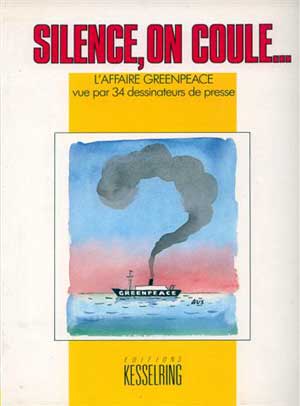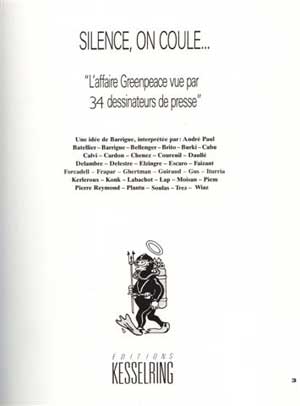Silence, on coule... : L’affaire Greenpeace vue par 34 dessinateurs de presse
By Hervé St-Louis
January 18, 2010 - 00:25
Éditions Kesselring
Writer(s): various
Penciller(s): Batellier, Cabu, Chenez, Faizant, Frapar, Gus, Iturria, Moisan, Piem, Plantu, Trez
ISBN: 2881590128
 |
Silence, on coule (Quiet, we’re sinking) is a compilation of editorial cartoons from French newspapers published a year after the alleged sinking of the Rainbow Warrior by the French secret service off the coast of New Zealand on July 10 1985. When protesting French nuclear testing in the Pacific Ocean, it is alleged that French services sunk the ship in retaliation. The affair created a diplomatic incident, lead to a rushed investigation and the resignation of a French Minister. This collection of editorial cartoon shows how various cartoonists from whether socialists or conservatives dealt with this issue in large newspapers and publications such as Le Monde and Le Figaro. It is a unique collection of historical relevance.
When I discussed the review of this book with my editor, we did discuss the narrow interest such a review would have for most readers and how some may feel it doesn’t even fit with comic strips. But my vision of comic strips, is one where they are newspaper artefacts part of a greater whole unlike a comic book. Editorial cartoons may be sequential or not, but they are cartoons. This book has not been reviewed elsewhere and little information is available online. It is also probably nearly impossible to buy a copy of this book today as it is out of print and from an obscure French publisher that probably doesn’t exist anymore. Yet, this book chronicles an important period of history that depicts how governments reacted to non governmental organizations denouncing their actions. The result was one death and a sunken ship and a lot of blaming and excuse and conspiracy allegations. I doubt that any of the most industrial powers would deal with a group like Greenpeace by sunking their ship nowadays. The event gave legitimacy to non governmental organization scrutiny in the affairs of states, while creating a martyr for Greenpeace in particular and a fire baptism.
 |
The cartoons in the book are decidedly French. There is some humour and irony, but unless one understands French politics of the Mitterrand era, one will be left in the dark as to the political persuasion of most cartoonists. Surprisingly, what they rendered was not the actual sinking of this ship in most of their drawings, but the political machinations of people alleged to be involved in the cover up. Here, in Canada, and by extension, the United States, we are used to much more vigorous and clear editorial cartoons which still mock their subjects, but leave no ambiguity in the mind of the reader. In France, it seems, all relates to the context and many cartoons use codes and metaphors which I was not used to before. It really feel like I had to be there to get the joke. What this book produces, is a very time specific time capsule into French political life that only a few intellects will completely appreciate. It is not to say that the irony and satire was off. It was very on. But there is less a quality of the king’s fool here than the king’s peers criticizing him while they are all part of the same book club. Thus the criticisms are more formal and gentle, and less disrupting as in North American cartoons where people being mocked are not spared very much.
In this series, one cartoonist stood out from the others. Jacques Faizant was my favourite. His line was the most familiar in terms of what I consider a cartoon or a comics strip. It was continuous and not broken. I also liked his commentaries the most. Other artists like Trez and Frappar were also fun to read, but most of the other cartoonists did not focus on the visual quality of their drawings but more on the propos of their editorials. Thus the cartoons were not used to convey all meanings to readers and the quality of the drawings did not seem to bother the readers of the time. It would be interesting to compare recent works and see if they have been “Americanized” over the years to leave a greater visual impression on readers. I suspect they would. Thus, at the time, the “serious” editorial cartoon had none of the visual cues and quality of regular French comic books which were always strong visual narratives. It seems cliché to write it, but the French may have favoured brains over artifacts. This is a book for historians and political scientists studying French international politics during the the Mitterrand presidency.
Rating: 8/10
Related Articles:
Les Derniers corsaires
